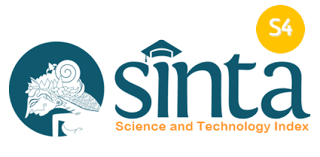LEARNING MEDIA VARIATION: STUDENTS’ PERCEPTION
DOI:
https://doi.org/10.36733/jsp.v12i2.5267Keywords:
Learning Media, Perception, VariationAbstract
Covid-19 has changed the ways of the teaching-learning process. Classroom activities are done with the use of technology and its varied platforms. This research aimed at describing the learning media variation for the learning process by considering the students’ perceptions. The participant is one class of eight grade students of SMP (SLUB) Saraswati 1 Denpasar. This research is a descriptive study. The data was collected by filling out an online questionnaire with Google forms and interviews. The result showed the indication of having variation in the learning media and, interestingly, the use of Google Classroom is considered effective for the students, but the teaching-learning process is done in face-to-face learning. It implies that learning variation is needed to support and facilitate classroom practice. Further study needs to be conducted for the sake of having in-depth studies related to learning variation in a face-to-face or hybrid context with a bigger number of participants.
Downloads
References
Code, J., Ralph, R., & Forde, K. (2020). Pandemic designs for the future: perspectives of technology education teachers during COVID-19. Information and Learning Sciences, 121(5/6), 419-431. http://dx.doi.org/10.1108/ILS-04-2020-0112
Damayanthi, F., & Rahmawati, M. (2022). The online learning process during the covid-19 pandemic. PROJECT (Professional Journal of English Education), 5(5), 1041-1046. http://dx.doi.org/10.22460/project.v5i5.p1041-1046
Haase, K. R., Cosco, T., Kervin, L., Riadi, I., & O'Connell, M. E. (2021). Older adults’ experiences with using technology for socialization during the COVID-19 pandemic: cross-sectional survey study. JMIR aging, 4(2), e28010. https://doi.org/10.2196/28010
Khatoony, S., & Nezhadmehr, M. (2020). EFL teachers' challenges in integration of technology for online classrooms during Coronavirus (COVID-19) pandemic in Iran. AJELP: Asian Journal of English Language and Pedagogy, 8(2), 89-104. https://doi.org/10.37134/ajelp.vol8.2.7.2020
Liliana, R. A., Raharjo, W., Jauhari, I., & Sulisworo, D. (2020). Effects of the online interactive learning media on student’s achievement and interest in physics. Universal Journal of Educational Research, 8(3). DOI: 10.13189/ujer.2020.081507
Pramerta, I. G. P. A., Perbawa, I. K. S. L. P., & Kristanti, W. (2021). Meningkatkan keberhasilan dan motivasi belajar siswa desa peguyangan kangin dengan pendampingan belajar online (PBO). Prosiding Seminar Regional Pengabdian Kepada Masyarakat Universitas Mahasaraswati Denpasar di Masa Pandemi Covid-19 Tahun 2021 (pp. 679-686).
Pramerta, I. G. P. A. (2018). Interactive video as English teaching materials for speaking. Jurnal Santiaji Pendidikan (JSP), 8(1). https://doi.org/10.36733/jsp.v8i1.162
Prasetya, S. P. (2018). Effect of learning media variation to increase interest and learning outcomes of geography. In 2nd International Conference on Education Innovation (ICEI 2018) (pp. 558-561). Atlantis Press. https://dx.doi.org/10.2991/icei-18.2018.122
Qiao, P., Zhu, X., Guo, Y., Sun, Y., & Qin, C. (2021). The development and adoption of online learning in pre-and post-COVID-19: Combination of technological system evolution theory and unified theory of acceptance and use of technology. Journal of Risk and Financial Management, 14(4), 162. https://doi.org/10.3390/jrfm14040162
Rahmawati, B. F. (2020). Learning by google classroom in students’ perception. In Journal of Physics: Conference Series (Vol. 1539, No. 1, p. 012048). IOP Publishing. doi:10.1088/1742-6596/1539/1/012048
Rasheed, R. A., Kamsin, A., & Abdullah, N. A. (2020). Challenges in the online component of blended learning: A systematic review. Computers & Education, 144, 103701. https://doi.org/10.1016/j.compedu.2019.103701
Subandi, S., Choirudin, C., Mahmudi, M., Nizaruddin, N., Hermanita, H., & Hermanita, H. (2018). Building interactive communication with Google Classroom. International Journal of Engineering & Technology, 7(2.13), 460-463. Retrieved from http://www.sciencepubco.com/index.php/IJET
Teräs, M., Teräs, H., Arinto, P., Brunton, J., Daryono, D., & Subramaniam, T. (2020). COVID-19 and the push to online learning: Reflections from 5 countries. Retrieved from https://www.theseus.fi/bitstream/handle/10024/345401/COVID_19_and_the_push.pdf?sequence=1
Topano, A., Walid, A., & Febrini, D. (2021). Improving student cognitive learning outcomes through the development of interactive multimedia-based biology learning at Muhammadiyah University, Bengkulu. In Journal of Physics: Conference Series (Vol. 1796, No. 1, p. 012042). IOP Publishing. doi:10.1088/1742-6596/1796/1/012042
Widodo, A., Ermiana, I., & Erfan, M. (2021). Emergency online learning: how are students’ perceptions?. In 4th Sriwijaya University Learning and Education International Conference (SULE-IC 2020) (pp. 263-268). Atlantis Press. https://dx.doi.org/10.2991/assehr.k.201230.116
Downloads
Published
Issue
Section
License
Copyright (c) 2022 FKIP Unmas Denpasar

This work is licensed under a Creative Commons Attribution 4.0 International License.











